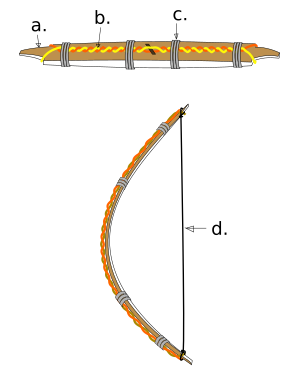Eskimo archery facts for kids
Traditional Inuit hunters were incredibly clever. They lived in places where it was tough to find the best wood for making bows, unlike hunters in warmer parts of the world. But they found a way! By using strong cords made from animal sinew (like tough threads from animal muscles) for the back of the bow, and spruce wood or antler for the front, they created very powerful weapons. These bows were so strong that when hunting polar bears, an arrow could go completely through the bear's body if it didn't hit a bone.
Contents
How Inuit Bows Are Made
Spruce wood was often the best material available for the front part of the bow. However, it's not very flexible when squeezed. Hunters also used driftwood, caribou antler, or musk ox horn.
First, they shaped the bow's main piece, called the stave. They used tools made of stone or iron. The stave was often wide, about 5 centimeters (2 inches), to help it handle the pressure when bent. If made from antler or bone, which are stiff and break easily, the stave might be made of several pieces. This allowed it to bend without breaking. The stave could be straight, curved forward (reflexed), or curved backward (deflexed).
The back of the bow was then made from caribou sinews. These sinews were twisted into strong cables. They were attached to the bowstave and to each other using knots. In warmer places, people used animal glue to attach sinew to bows. But this wasn't practical in the Arctic. Animal glue freezes almost instantly in cold air. Also, Inuit culture traditionally didn't have the fuel or pots needed to boil things for a long time to make glue.
Sometimes, the knotted cables were raised slightly from the back of the bowstave. They used small spacers to do this. This made the bow lighter and work even better.
The way these sinew-backed bows worked could change with the amount of moisture in the air. So, hunters often had to adjust their bows. They adjusted the tension by twisting the backing cables. They used short rods made of ivory, wood, or bone, which they inserted through the cables.
Other cultures besides the Inuit also made cable-backed bows. The Tlingit and Haida people made similar bows. A special type of cable-backed bow is the Penobscot bow. It was invented by Frank Loring (Chief Big Thunder) around 1900. This bow had a smaller bow attached by cables to the back of a larger main bow.
Different Kinds of Arrows
Hunters used different kinds of arrows for different animals. For small animals like birds, lemmings, or ground squirrels, they used blunt arrowheads. These arrows would stun the animal without tearing a big hole in it. Sometimes, boys' arrows even had empty copper cartridge cases as blunt heads. These could shoot clean through a small bird.
For hunting larger animals, traditional Inuit arrows had barbs. Often, their heads could detach from the shaft. For hunting reindeer, the arrow had a long, sharp, bayonet-shaped head. It was made of antler, had barbs on one side, and fit loosely into the shaft. If a hunter hit a deer, the shaft could fall out. The barbed head would stay in the wound. The Inuit said the deer would "sleep one night, and then die."
For large birds like geese or gulls, arrows had long, five-sided heads. These were made of walrus ivory. They weren't super sharp but had barbs on one edge. Arrows for hunting sea otters were red and attached loosely to the barb with a long red cord. A hunter would shoot and then chase the sea otter. The trailing arrow shaft would make it harder for the otter to swim. The hunter could see the bright red shaft and find the sea otter, which would be tired from the chase.
Keeping Arrows Safe: Quivers
Hunters used special cases made of sealskin to protect their bows and arrows from moisture. These cases also held small ivory tools. These tools were used to twist, tighten, and adjust the bow and its cables when needed.
In the late 1800s, people noted these sealskin cases for bows and sealskin quivers for arrows. The bow was carried, ready to use, in a sealskin sheath. This sheath was slung across the shoulders. It was easy to pull the bow out from under the right arm. Today, hunters carry their rifles in similar sheaths. A quiver, also made of sealskin, was attached to the sheath. Hunters kept a mix of arrows in the quiver, different kinds for different hunting needs.
Images for kids




